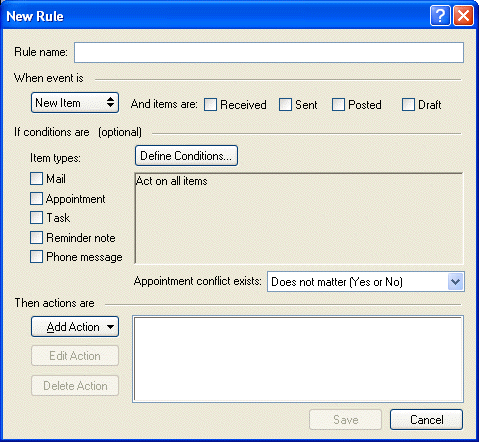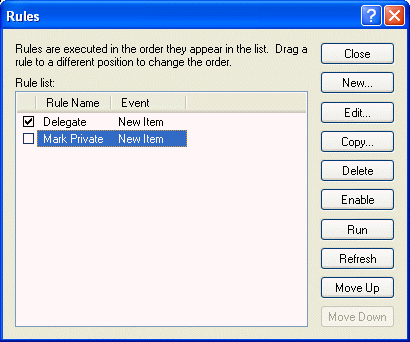7.8 Creating Rules
You can automate many GroupWise actions, such as replying when you’re out of the office, deleting items, or sorting items into folders, by using Rules to define a set of conditions and actions to be performed when an item meets those conditions.
When you create a rule, you must do the following:
-
Name the rule.
-
Select an event. The event is the trigger that starts the rule.
-
Select the types of items that will be affected by the rule.
-
Add an action. The action is what you want the rule to do when it is triggered.
-
Save the rule.
-
Make sure the rule is enabled.
You can specify many more options to limit which items a rule affects. For example, you can apply a rule to only accepted appointments, to items with a certain word in the Subject box, or to items with a high priority. Use Define Conditions to limit your rules further. See Limiting Items Affected by a Rule.
This section contains the following topics:
7.8.1 Actions a Rule Can Perform
Table 7-6 Actions a Rule Can Perform
7.8.2 Events That Trigger a Rule
Table 7-7 Events That Trigger a Rule
7.8.3 Creating a Rule
-
Click > , then click .

-
Type a name in the field.
-
Click the pop-up list, then click an event to trigger the rule.
-
If you clicked , , , or , click one or more sources for the item. For example, click and .
or
If you clicked , , or , click the folder icon, click a folder, then click to display the folder name.
-
Click one or more types of items you want the rule to act on in the Item Types list.
If you want to further restrict the items affected by the rule, click , click the appropriate options, then click . For more information, see Limiting Items Affected by a Rule.
-
Click , then click the action you want the rule to perform.
Some actions such as Send Mail and Reply require you to fill in additional information.
-
Click .
For a rule to function, it must be enabled. See Enabling or Disabling a Rule.
7.8.4 Creating a Vacation Rule or Auto Reply
-
Click > , then click .
-
Type a name in the field, such as Vacation Rule.
-
Click the pop-up list, then click Item.
-
Next to , select . Make sure no other item source is selected.
-
Do not make any selections under .
-
Use Define Conditions to add specific information to your rule. The following are examples of using Define Conditions.
-
If you want to set up the dates during which the rule is in effect. Click , click in the first drop-down list, click in the second drop-down list, then in the date field, select the date you are leaving on vacation. Click the pop-up list, then click . On the new line, click in the first drop-down list, click in the second drop-down list. In the date field, select the date you are returning from vacation, and click .
-
If you want to make sure you reply only to items that are sent specifically to you (and not to list servers or newsgroups). Click . If you have already specified information in this dialog box, click the pop-up list, then click . On the new line, click in the first drop-down list, click in the second drop-down list, then in the next field, type your name as it displays in the To field of a mail message.
-
If you want to make sure that you do not reply to items from yourself (possible through delayed delivery, proxies, and so forth). Click . If you have already specified information in this dialog box, click the pop-up list, then click . On the new line, click in the first pop-up list, click in the second drop-down list, in the next field, type your name as it displays in the From field of a mail message, then click .
-
If you want to reply to internal items only. Click . If you have already specified information in this dialog box, click the pop-up list, then click . On the new line, click in the first drop-down list, click in the second drop-down list; in the next field, type , then click .
-
-
Under , click , then click .
The Reply dialog box is displayed, showing Reply to Sender selected (you cannot select ). If you want your reply to include the sender’s original message, select . Click .
-
Type a message, for example:
I will be out of the office from September 3-September 10. If you need assistance during this time, please contact Martha Robbins at extension 1234.
-
Click .
-
Click , verify that the rule has a check mark next to it indicating that it is enabled, then click .
Rules that trigger a reply (such as this vacation rule) keep a record of who a reply has been sent to, and make sure that a reply is sent only once to that user.
7.8.5 Creating a Rule to Forward All Mail to a Private Mail Account
-
Click > , then click .
-
Type a name in the field, such as Forward Rule.
-
Click the pop-up list, then click .
-
Next to , select . Make sure no other item source is selected.
-
Select under .
-
Click , then select .
-
Type the address that you want the items forwarded to in the field.
-
Type a subject you want to use for forwarded items, for example frwd:.
-
(Optional) Type a name of a filter to use for forwarded items.
-
(Optional) Type a message for all forwarded items.
-
Click .
-
Click , verify that the rule has a check mark next to it indicating that it is enabled, then click .
7.8.6 Copying a Rule to Make a New Rule
-
Click > .
-
Click the rule you want to copy, then click .
-
Type the name of the new rule.
-
Make changes to the rule.
-
Click .
7.8.7 Editing a Rule
-
Click > .
-
Click the rule you want to edit, then click .
-
Make changes to the rule.
-
Click .
7.8.8 Deleting a Rule
-
Click > .
-
Click the rule you want to delete, click , then click .
7.8.9 Limiting Items Affected by a Rule
Use Define Conditions to further limit the items affected by a rule.
-
In the Rules dialog box, click .
-
Click the first drop-down list, then click a field.
To learn about what the fields represent, see Understanding Filter and Rule Fields.
-
Click the operator drop-down list, then click an operator.
To learn how to use operators, see Using Filter and Rule Operators.
-
Type the criteria for the filter.
or
If a drop-down list is provided, click the drop-down list, then click existing criteria.
If you type criteria, such as a person’s name or a subject, you can include wildcard characters such as an asterisk (*) or a question mark (?). Text you type is not case-sensitive.
To learn more about wildcard characters and switches, see Using Filter and Rule Wildcard Characters and Switches.
-
Click the last drop-down list, then click .
or
Click the last drop-down list, then click or to further limit the items affected by the rule.
7.8.10 Running a Rule Manually
-
Click the items or folders that you want affected by the rule.
-
Click > .
-
Click the rule you want to run.
-
Click Run, then click .
The rule actions occur after you close the Rules dialog box.
7.8.11 Enabling or Disabling a Rule
A rule must be enabled before it can be triggered. When you disable a rule, the rule cannot be triggered. However, the rule is still listed in the Rules dialog box so you can enable it when you need it again.
-
Click > .

-
Click the rule you want to enable or disable.
-
Click or .
An enabled rule has a check mark in the box.